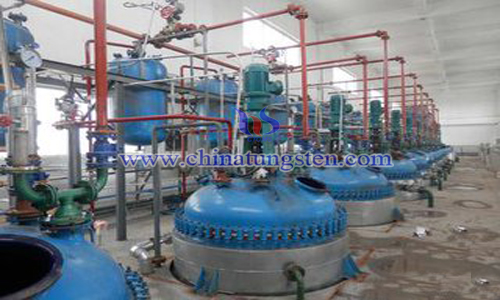Tin Removal by Magnesium Salt Precipitation Method
- Details
- Category: Tungsten Information
- Published on Thursday, 07 June 2018 16:40
Due to the increasing shortage of tungsten resources and more and more high impurities and low grade ores entering the tungsten smelting process, the content of impurities such as silicon, phosphorus, arsenic and tin in the sodium tungstate solution obtained by tungsten is becoming higher and higher. In order to produce tungsten products such as high purity ammonium para tungstate (APT) and tungsten oxide, sodium tungstate solution must be clean.

In alkali treatment, magnesium salt precipitation method is usually used to add magnesium sulfate and other magnesium salts to sodium tungstate solution, so that silicon, tin and magnesium (as) magnesium salts are precipitated to achieve the purpose of removing arsenic, magnesium, silicon and tin. When the content of tin and silicon impurities in tungstate solution is high, the purification effect is not good.
On the basis of magnesium salt precipitation, the researchers first oxidize the sodium tungstate solution before adding magnesium sulfate, arsenic, tin and silicon, then adjust the alkalinity of the solution to 1.2 ~ 2.6g/l, then add the soluble iron salt solution containing Fe3+. The addition of iron salt is calculated to Fe: WO3 = 1~4: 1000 according to the weight ratio. After mixing for 30~60 minutes, the filtrate was then treated with magnesium salt precipitation when the alkalinity was 1 to 1.2g/l and the solution was boiled.
The method for the removal of tin is to heat and oxidize the sodium tungstate solution in advance by adding oxidant to ensure that the Fe3+ salt is not reduced to Fe2+ salt by the low reduction substance in the solution, and the Sn and Si will be hydrolyzed under the weak alkaline condition of the sodium tungstate solution alkalinity to 1.2 ~ 2.6g/l. The Fe(OH)3 charged colloid produced by the iron salts will adsorb Sn(OH)4 and H2SiO3 and gather together to achieve common precipitation in a short time. The content of tin and silicon in the solution can be reduced by filtration and separation of precipitates. After adding the filtrate to magnesium salt, the residual silicon and tin can further sink with the formed phosphorus (arsenic) magnesium salt, so as to achieve deep purification of tin, silicon, especially tin removal, as well as arsenic and phosphorus.
The improved magnesium salt precipitation process is simple and suitable for purifying sodium tungstate solution containing high content of tin and silicon.
- Tungsten Manufacturer & Supplier, Chinatungsten Online: www.chinatungsten.com
- Tungsten News & Prices of China Tungsten Industry Association: www.ctia.com.cn
- Molybdenum News & Price: news.molybdenum.com.cn
- Tel.: 86 592 5129696; Fax: 86 592 5129797; Email: sales@chinatungsten.com



 sales@chinatungsten.com
sales@chinatungsten.com